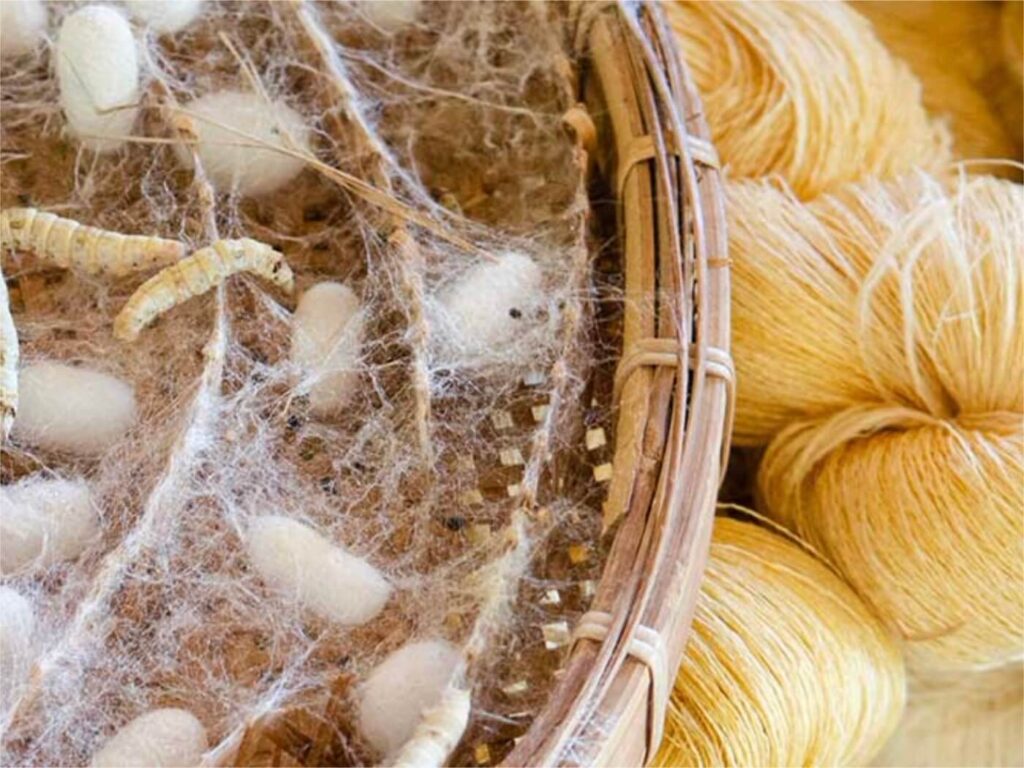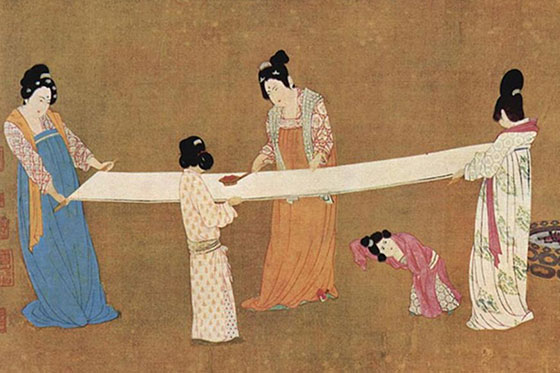Silk is commonly known as the queen of textiles. If you are curious to learn more about this amazing material, you have come to the right place. This article is all about the complete vocabulary about silk, the various types of silk fibers, the benefits of wearing it, and some history of its cultivation and production. Let’s dive deeper into this natural fiber and explore more about it below.

What is silk fabric?
Silk is a protein fiber that naturally exists in the silkworm cocoon. Fiber is made up of fibroin protein, which gives silk fabric strength and softness. It is also lightweight and softer than other fibers.
How is silk made?
Silk is made from silkworm cocoons. In a more scientific term, it comes from the larvae of the silk moth. The silk-making process itself begins when the female silk moth lays eggs. Subsequently, the eggs turn into larvae (silkworms), and they start to eat leaves.
The majority will eat mulberry leaves (Morus alba). Some of the silkworms will eat castor (Ricinus communis), som (Persea bombycina), and soalu (Litsaea polyantha Juss) leaves.
Over a period of several weeks, the silkworms multiply at a tremendous rate. Meanwhile, they will eat a lot of mulberry leaves to get bigger and stronger. The larvae are completely grown in about 4 to 6 weeks.
Once the silkworms have grown big enough, they will stop eating and start making their cocoons. During this period, they will secrete protein-rich substances like sericteria. When the protein gets in contact with air, it hardens, and then the thread of silk that is long will be formed.
Silkworms spin a single strand of silk by shaking their bodies to form a cocoon. Once spun, the cocoons are boiled to dissolve the gluey material and kill the cocoons. The silk filaments are then unwound with care and twisted into stronger fibers to create yarn and then fabrics. All this can take weeks to do and is a lot of work and expertise.
The history of silk

Silk was first discovered in China by Xiling Shi around 3000 BCE. When she was walking on the road, the first silkworm cocoon fell into her tea from a mulberry tree. Then the strong white thread unraveled. Curious about what she had found, she took the cocoon and went to her laboratory to investigate further.
After conducting experiments, she discovered that the thread was produced by the silkworm and could be unwound to create a delicate, strong fiber. For a long time, China did not reveal, and they kept the secret of silk production to themselves. Eventually, the secret was revealed to other countries, and the process of sericulture spread worldwide.
Some of the popular types of silk fabric
Many types of silk are produced by different kinds of silkworms. Some of them are explained below.
Mulberry silk
Mulberry silk is the most general and finest quality of silk. It is harvested from silkworms nourished with mulberry leaves. The highest quality of silk is available for purchase. There are so many mulberry silk benefits, such as being silky, very fine and soft, durable, and having a bright luster.
To get the best quality silk, the cocoons are boiled before the silkworms come out. This keeps the silk threads long and strong. If we wait for the silkworm to leave on its own, the thread breaks and the silk isn’t as fine as we expect. India is the second-largest mulberry silk producer country after China.
Eri silk / Wild silk / Ahimsa silk
Wild silk is extracted from silkworms naturally living in the wild. It is slightly rougher and has a less smooth texture than mulberry silk. But it is manufactured without killing silkworms. That is why it is known as peace silk.
The silkworms are completing their natural life cycle. Silk is reeled after they have exited the cocoon. This process is more environmentally friendly and is typically done through traditional artisanal weaving methods. The eri silk is produced more in northeastern states in India.
Tussar silk
Tussar silk, also known as Kosa silk, is a beautiful and natural silk made from the cocoons of silkworms (Antheraea genus), mainly found in forests of India. Tussar silk has a rich texture and a natural golden sheen. It is perfect for traditional sarees, scarves, and other handwoven garments.
What makes tussar silk special is its lightweight feel and slightly coarse texture, which gives it a raw, earthy charm. It is breathable and comfortable to wear, especially in warmer weather.
Muga silk
Muga silk is also known as the golden silk of Assam (India). It is the product of the silkworm Antheraea assamensis. It is naturally durable and has a yellowish-golden tint with a glossy texture. It takes around 1000 cocoons to produce 125 grams of silk. However, this silk has high demand because of its natural golden gloss and delicate texture.
Specific vocabulary used for silk fabric
Satin 60
It has a smooth and glossy surface due to its weaving technique. “60” is a thread density, and it indicates a moderate weave for a shiny finish. The weight of the Satin 60 is 60 g/m2.
Satin 80
Satin 80 is almost similar to Satin 60, but it has a tighter weave on the fabric. It gives shine to the fabric, and its weight is 80 g/m2. Its higher thread count and more vibrant sheen give a refined appearance.
Georgette silk
It was originally made from pure silk. Silk georgette is slightly delicate. It can be worn in any season. It is more popular in the summer due to its airy and light texture.
Chiffon silk
This fabric is designed from silk. The smooth chiffon silk is a natural fiber. However, the crinkled chiffon silk is still considered a lightweight and airy material to wear.
Velvet silk
Velvet silk is very soft and silky to the touch. While it is heavier than many other fabrics. It is costlier because it is completely made from pure silk.
Recycled silk
Recycled silk is created by reusing and repurposing silk waste, such as old garments, offcuts, discarded silk cocoons, and many more. It helps to reduce the need for new silk production, and it also uses 30-50% less energy compared to producing new silk.
Crepe de chine
It is a versatile fabric suitable for both formal wear and casual wear. The crepe de chine silk is lightweight and breathable, and it makes it perfect for summer or warmer climates.
Organza
The organza silk is plain woven fabric and is a highly transparent material. It is a very sheer material, and it is also a lightweight material.
7 Properties and benefits of silk

- It regulate body temperature keeping you warm in cold weather and cool in warm weather
- Silk looks fine and delicate, but it is very strong and durable.
- As it is hypoallergenic, it suits sensitive skin very well.
- Breathable and comfortable with your skin.
- Highly absorbent
- It has a natural shine that looks beautiful.
- As well as silk being biodegradable and an eco-friendly choice for your projects.
Final thoughts
As you’ve seen all about this silk fabric, it has a highly soft texture and breathable material. That is why it is the most expensive material. Wear soft and smooth silk fabrics for a more comfortable feel and for safety for your skin.
If you are searching for natural and sustainable fabrics to buy, at Green Tailor, we offer ready-to-dye and breathable fabrics and products worldwide. You can get cotton, linen, silk, wool, and many more fabrics and products at affordable prices.
Do you have any questions to clarify? You can contact us by mailing us at [email protected].
